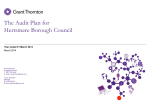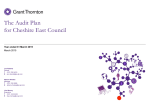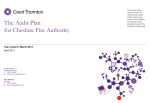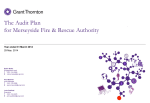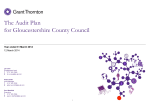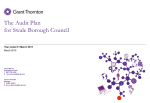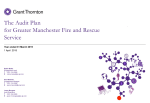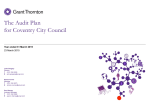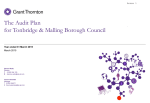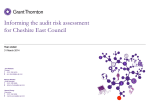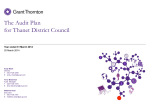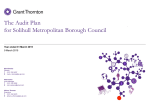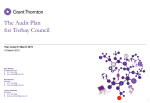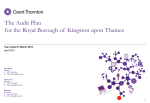Download The Audit Plan – template user guide
Transcript
The Audit Plan for Cheshire East Council Year ended 31 March 2014 14 March 2014 Jon Roberts Engagement lead T 0121 232 5410 E [email protected] Allison Rhodes Manager T 0121 232 5285 E [email protected] Naomi Povey Executive T 0121 232 5294 E [email protected] © 2014 Grant Thornton UK LLP | The contents of this report relate only to the matters which have come to our attention, which we believe need to be reported to you as part of our audit process. It is not a comprehensive record of all the relevant matters, which may be subject to change, and in particular we cannot be held responsible to you for reporting all of the risks which may affect the Council or any weaknesses in your internal controls. This report has been prepared solely for your benefit and should not be quoted in whole or in part without our prior written consent. We do not accept any responsibility for any loss occasioned to any third party acting, or refraining from acting on the basis of the content of this report, as this report was not prepared for, nor intended for, any other purpose. Contents Section Page Understanding your business 4 Developments relevant to your business and the audit 5 Our audit approach 6 Significant risks identified 7 Other risks identified 8 Value for Money 10 Interim audit work 11 Key dates 12 Fees and independence 13 Communication of audit matters with those charged with governance 15 © 2014 Grant Thornton UK LLP | Understanding your business In planning our audit we need to understand the challenges and opportunities the Council is facing. We set out a summary of our understanding below. Challenges/opportunities 1. Financial pressures 2. Commissioning Council 3. Capital investment The 2014/2015 budget proposals are balanced. The on going reductions in government funding results in budget deficits in the medium term. The Council is developing a mix of delivery models to deliver its services. Moving to be a commissioning council, there is to be an increasing number of arms length companies, to provide the benefits of a more commercial approach to services, balanced with effective governance and accountability. The Council had a three year capital programme of £223m for 2013/2016 funded from external grants and contributions, capital receipts, prudential borrowing and revenue contributions. Moving forward the 2014–17 capital plan is expected to be flexed to maximise funding opportunities. 4. Management restructure During 2013, the Council has restructured its Corporate Leadership Team. The senior management team is now in place to take the Council forward in developing governance arrangements appropriate to its strategic direction. 5. Better Care Fund The Better Care Fund (formerly the integrated transformation fund) is a single pooled budget for health and social care services to work more closely together in local areas. Authorities need to plan with their partners for access to the fund by submitting plans in early 2014. 6. Arrangements to protect children The Council has an improvement plan to address recommendations from the Ofsted inspection (published in April 2013) which concluded the arrangements to protect children to be inadequate. The Council also received an Improvement Notice. Our response We will consider the Council's response to the financial pressures as part of our work to support the value for money conclusion (financial resilience). As part of our accounts audit, we review the assertion that the Council operates as a going concern. © 2014 Grant Thornton UK LLP | We will review the Council's arrangements for identifying and reflecting the financial implications of the alternative delivery models in its medium term financial plans, as part of our work for the VFM conclusion. We will review how the Council puts in place new governance structures to support these changes in service delivery, through our regular meetings with senior management and those charged with governance. We will reference this review to our national research contained within our local government governance survey 'Working in Tandem' and our report on alternative delivery models in local government 'Responding to the Challenge'. We will review the Council's capital programme and funding arrangements (including plans to secure capital receipts through the reconfiguration of its asset base) through our discussions with management and substantive testing. We will meet with senior management and members on a regular basis to discuss their response to the opportunities and challenges facing the Council. We will monitor the Council's progress in planning for its role under the Better Care Fund. As part of our VFM audit, we will consider the evidence of improvement in this area, such as the progress of the Children's Improvement Plan, and its monitoring by the Improvement Board. 4 Developments relevant to your business and the audit In planning our audit we also consider the impact of key developments in the sector and take account of national audit requirements as set out in the Code of Audit Practice ('the code') and associated guidance. Developments and other requirements 1.Financial reporting 2. Legislation 3. Corporate governance 4. Pensions 5. Financial Pressures 6. Other requirements Changes to the CIPFA Code of Practice Local government finance settlement Annual Governance Statement (AGS) Managing service provision with less resource Clarification of Code requirements around PPE valuations Welfare reform Act 2012 Explanatory foreword The impact of changes to the accounting requirements for the Local Government pension Scheme (LGPS) The Council is required to submit a Whole of Government accounts pack on which we provide an audit opinion Changes to NDR accounting and provisions for business rate appeals Incorporating efficiency savings into the 2013/14 revenue budget and medium term financial plans The Council completes grant claims and returns on which audit certification is required Transfer of assets to Academies Our response Through discussions with management and our substantive testing, we will ensure that: the Council complies with the requirements of the CIPFA Code of Practice the Council accounts appropriately for NDR and provides for the impact of business rate appeals schools are accounted for correctly and in line with the latest guidance. © 2014 Grant Thornton UK LLP | We will discuss the impact of the legislative changes with the Council through our regular meetings with senior management and those charged with governance, providing a view where appropriate. We will review the arrangements the Council has in place for the production of the AGS We will review the AGS and the explanatory foreword to consider whether they are consistent with our knowledge We will review how the Council deals with the accounting and financing impact of the 2013/14 changes through discussions with management and our substantive testing. We will review the Council's performance against the 2013/14 budget. We will carry out work on the WGA pack in accordance with requirements. We will review the Council's Financial Resilience as part of our VFM conclusion. We will certify grant claims and returns in accordance with Audit Commission requirements. We will apply the findings of our national research in this area. 5 Our audit approach Ensures compliance with International Standards on Auditing (ISAs) Global audit technology Understanding the environment and the entity Understanding the business Inherent risks Significant risks Understanding management’s focus Other risks Evaluating the year’s results Material balances Develop audit plan to obtain reasonable assurance that the Financial Statements as a whole are free from material misstatement and prepared in all materiala respects with the CIPFA Code of Practice framework using our global methodology and audit software Devise audit strategy (planned control reliance?) Yes Extract your data No Test controls Test of detail IDEA Substantive Substantive Analyse data analytical analytical Report output using relevant review review to teams parameters Tests of detail General audit procedures Note: a. An item would be considered material to the financial statements if, through its omission or nondisclosure, the financial statements would no longer show a true and fair view. Financial statements Conclude and report Creates and tailors audit programs © 2014 Grant Thornton UK LLP | Stores audit evidence Documents processes and controls 6 Significant risks identified 'Significant risks often relate to significant non-routine transactions and judgmental matters. Non-routine transactions are transactions that are unusual, either due to size or nature, and that therefore occur infrequently. Judgmental matters may include the development of accounting estimates for which there is significant measurement uncertainty' (ISA 315). In this section we outline the significant risks of material misstatement which we have identified. There are two presumed significant risks which are applicable to all audits under auditing standards (International Standards on Auditing – ISAs) which are listed below: Significant risk Description Substantive audit procedures The revenue cycle includes fraudulent transactions Under ISA 240 there is a presumed risk that revenue may be misstated due to the improper recognition of revenue. Work planned: Under ISA 240 there is a presumed risk that the risk of management over-ride of controls is present in all entities. We have discussed with management the rationale and evidence to support key accounting estimates and judgements. Management over-ride of controls © 2014 Grant Thornton UK LLP | Review and testing of revenue recognition policies Testing of material revenue streams Work planned: Review of accounting estimates, judgments and decisions made by management Testing of journal entries Review of significant and unusual transactions 7 Other risks identified The auditor should evaluate the design and determine the implementation of the entity's controls, including relevant control activities, over those risks for which, in the auditor's judgment, it is not possible or practicable to reduce the risks of material misstatement at the assertion level to an acceptably low level with audit evidence obtained only from substantive procedures (ISA 315). In this section we outline the other risks of material misstatement which we have identified as a result of our planning. Other reasonably possible risks Operating expenses Description Work programme Creditors understated or not recorded in the correct period We will document the processes and controls in place around the accounting for operating expenses and carry out walkthrough tests to confirm the operation of controls We will carry out testing including: the completeness of the subsidiary system interfaces and control account reconciliations reviewing the monthly trend analysis of payments cut off testing of purchase orders and goods received notes (both before and after year end) Testing will also cover a sample of operating expenses covering the period 1/4/13 to 31/3/14 to ensure they have been accurately accounted for and in the correct period. Employee remuneration Employee remuneration accrual understated We will document the processes and controls in place around the accounting for employee remuneration and carry out walkthrough tests to confirm the operation of controls. We will carry out testing including: the completeness of the payroll reconciliation to ensure that information from the payroll system can be agreed to the ledger and financial statements a sample of payments made in April & May to ensure payroll expenditure is recorded in the correct year. reviewing the monthly trend analysis of total payroll Testing will also cover a sample of employee remuneration payments covering the period 1/4/13 to 31/3/14 to ensure they have been accurately accounted for and in the correct period. © 2014 Grant Thornton UK LLP | 8 8 Other risks identified continued The auditor should evaluate the design and determine the implementation of the entity's controls, including relevant control activities, over those risks for which, in the auditor's judgment, it is not possible or practicable to reduce the risks of material misstatement at the assertion level to an acceptably low level with audit evidence obtained only from substantive procedures (ISA 315). In this section we outline the other risks of material misstatement which we have identified as a result of our planning. Other reasonably possible risks Description Work programme Welfare Expenditure Welfare benefit expenditure improperly computed We will document the processes and controls in place around the accounting for welfare benefits and carry out walkthrough tests to confirm the operation of controls. We will carry out testing in accordance with the methodology required to certify the housing benefit subsidy claim. Property, Plant & Equipment PPE activity not valid We will document the processes and controls in place around the accounting for PPE and carry out walkthrough tests to confirm the operation of controls. We will carry out substantive testing on a sample of PPE transactions covering the period 1/4/13 to 31/3/14. Property, Plant & Equipment Revaluation measurement not correct We will document the processes and controls in place around the accounting for revaluations of PPE and carry out walkthrough tests to confirm the operation of controls. We will review the qualifications, term of reference and the assumptions and methods used by the Valuer, in work carried out as an expert for the Council. We will review valuation reports to support the accounting entries. © 2014 Grant Thornton UK LLP | 9 9 Value for money Value for money The Code requires us to issue a conclusion on whether the Council has put in place proper arrangements for securing economy, efficiency and effectiveness in its use of resources. This is known as the Value for Money (VfM) conclusion. Our VfM conclusion is based on the following criteria specified by the Audit Commission: VfM criteria Focus of the criteria The organisation has proper arrangements in place for securing financial resilience The organisation has robust systems and processes to manage financial risks and opportunities effectively, and to secure a stable financial position that enables it to continue to operate for the foreseeable future The organisation has proper arrangements for challenging how it secures economy, efficiency and effectiveness The organisation is prioritising its resources within tighter budgets, for example by achieving cost reductions and by improving efficiency and productivity We have undertaken a risk assessment to identify areas of risk to our VfM conclusion. We will undertake work in the following areas to address the risks identified: • Review the Council's financial resilience, as reflected in the medium term financial strategy and the savings factored into the annual budgets. • Review the Council's arrangements for identifying and reflecting the financial implications of the development of alternative delivery models in its medium term financial plans. • Review the Council's progress in planning for its role under the Better Care Fund (previously Integration Transformation Fund). • Review the evidence of improvements in the arrangements to protect children following the Ofsted inspection report published in April. • Review the Council's progress in implementing actions to address the matters raised in the 2012/13 VfM conclusion specifically: • arrangements to procure goods and services. • understanding of costs and performance. • arrangements to develop business proposals and manage significant projects. The results of our VfM audit work and the key messages arising will be reported in our Audit Findings report and in the Annual Audit Letter. © 2014 Grant Thornton UK LLP | 10 Interim audit work We will report the results of our interim work to the June meeting of the Audit and Governance. The work to be carried out is detailed in the table below. Should the outcome of our interim work impact upon our overall audit plan and strategy, we will report any changes back to those charged with governance. Internal audit Work to be performed Outcome of the work to be performed We review internal audit's overall arrangements in accordance with auditing standards. We will conclude whether the internal audit service continues to provide an independent and satisfactory service to the Council and that internal audit work contributes to an effective internal control environment at the Council. We also review internal audit's work on the Council's key financial systems to date. Our review of internal audit work will identify whether there are any weaknesses which impact on our audit approach. Walkthrough testing We complete walkthrough tests of controls operating in areas where we consider that there is a risk of material misstatement to the financial statements. This covers some procedures operated by the shared service provider (under the partnership arrangement with Cheshire West and Chester). We will conclude whether our work has identified any weaknesses which impact on our audit approach. Our work determines whether internal controls have been implemented in accordance with our documented understanding. Review of information technology controls Our information systems specialist performs a high level review of the general IT control environment, as part of the overall review of the internal controls system. We also perform a follow up of the issues that were raised last year. We will conclude whether our work identifies any material weaknesses which are likely to adversely impact on the Council's financial statements. Journal entry controls We review the Council's journal entry policies and procedures as part of determining our journal entry testing strategy. The work will identify whether there any material weaknesses which are likely to adversely impact on the Council's control environment or financial statements. Early substantive testing We will complete testing on initial samples of employee remuneration, operating expenses and income. The work will inform our approach to the audit of the Council's accounts and contribute to the assurance for material items. © 2014 Grant Thornton UK LLP | 11 Key dates The audit cycle March 2013 Interim audit visit July – August 2014 Final accounts Visit September 2014 September 2014 Completion/ reporting Debrief Key phases of our audit 2013-2014 Date February 2014 Planning 10 March 2014 Interim site visit 27 March 2014 Presentation of initial audit plan to Audit and Governance 21 July – August 2014 Year end fieldwork September 2014 (TBA) Audit findings clearance meeting with Head of Corporate Resources & Stewardship 18 September 2014 Report audit findings to those charged with governance (Audit and Governance Committee) week commencing 22 September 2014 © 2014 Grant Thornton UK LLP | Activity Sign financial statements opinion 12 Fees and independence Fees Fees for other services £ £ Council audit 205,050 Grant certification Total fees (excluding VAT) None Nil 26,900 231,950 Our fee assumptions include: Independence and ethics Supporting schedules to all figures in the accounts are supplied by the agreed dates and in accordance with the agreed upon information request list Ethical standards and International Standards on Auditing (ISA) 260 require us to give you full and fair disclosure of matters relating to our independence. In this context, we have previously reported to the Audit and Governance Committee, the safeguards to mitigate the threat to the independence of the auditor arising from the appointment of the former Engagement Lead to the post of Head of Corporate resources and Stewardship (Deputy Section 151 officer). These arrangements have been agreed with the Audit Commission and are repeated at page 14 of this audit plan. The scope of the audit, and the Council and its activities, have not changed significantly The Council will make available management and accounting staff to help us locate information and to provide explanations It is important to note that the actual certification fees for 2013/14 may be higher or lower than the indicative fee stated above, because the auditor is required to undertake more or less work compared to 2011/12 on which the fee is based. Auditors must seek the agreement of the Audit Commission to any variation to the grant certification fee. We have complied with the Auditing Practices Board's Ethical Standards and therefore we confirm that we are independent and are able to express an objective opinion on the financial statements. Full details of all fees charged for audit and non-audit services will be included in our Audit Findings report at the conclusion of the audit. We confirm that we have implemented policies and procedures to meet the requirement of the Auditing Practices Board's Ethical Standards. © 2014 Grant Thornton UK LLP | 13 Independence In January 2014 Judith Tench joined Cheshire East Council as Head of Corporate Resources and Stewardship (Deputy s151 Office). Judith was formerly employed by Grant Thornton UK LLP and was the engagement lead for the external audit of the Council. This appointment poses a threat (actual or perceived) to the independence of the auditor. In these circumstances we have taken actions to safeguard the independence of the firm and of the auditor, in accordance with the Ethical Standards and the Audit Commission's Standing Guidance. A summary of these safeguards are set out below. We will also disclose this threat and these safeguards in our audit findings report. We have discussed these safeguards with the Council's Leader, Chief Executive and Chief Operating Officer. We have also discussed and agreed these safeguards with the Audit Commission. Safeguards to mitigate the threat to the independence of the auditor • Judith withdrew from the audit team as soon as she advised her interest in applying for the role at the Council and alternative arrangements were put in place to discuss and finalise the Annual Audit Letter and to certify two grant claims. This concluded the 2012/13 audit. • For the 2013/14 audit all senior members of the team are now replaced by individuals who have not previously worked with Judith. Your new audit team are set out on page 4. • As an additional safeguard the team are from another Grant Thornton region (Midlands) and are headed up by the Regional Lead Partner for the Midlands - Jon Roberts. Your new audit team also includes Allison Rhodes and Naomi Povey. • The audit engagement team will not conduct any meetings with Judith without another Council officer being present. This additional safeguard will continue for the next two years. • In addition we confirm that Judith has no residual financial relationships with the firm. © 2014 Grant Thornton UK LLP | 14 Communication of audit matters with those charged with governance International Standards on Auditing (ISA) 260, as well as other ISAs, prescribe matters which we are required to communicate with those charged with governance, and which we set out in the table opposite. This document, The Audit Plan, outlines our audit strategy and plan to deliver the audit, while The Audit Findings will be issued prior to approval of the financial statements and will present key issues and other matters arising from the audit, together with an explanation as to how these have been resolved. Our communication plan Audit Audit plan findings Respective responsibilities of auditor and management/those charged with governance Overview of the planned scope and timing of the audit. Form, timing and expected general content of communications We will communicate any adverse or unexpected findings affecting the audit on a timely basis, either informally or via a report to the Council. Views about the qualitative aspects of the entity's accounting and financial reporting practices, significant matters and issue arising during the audit and written representations that have been sought Respective responsibilities Confirmation of independence and objectivity This plan has been prepared in the context of the Statement of Responsibilities of Auditors and Audited Bodies issued by the Audit Commission (www.auditcommission.gov.uk). A statement that we have complied with relevant ethical requirements regarding independence, relationships and other matters which might be thought to bear on independence. We have been appointed as the Council's independent external auditors by the Audit Commission, the body responsible for appointing external auditors to local public bodies in England. As external auditors, we have a broad remit covering finance and governance matters. Details of non-audit work performed by Grant Thornton UK LLP and network firms, together with fees charged. Our annual work programme is set in accordance with the Code of Audit Practice ('the Code') issued by the Audit Commission and includes nationally prescribed and locally determined work. Our work considers the Council's key risks when reaching our conclusions under the Code. It is the responsibility of the Council to ensure that proper arrangements are in place for the conduct of its business, and that public money is safeguarded and properly accounted for. We have considered how the Council is fulfilling these responsibilities. © 2014 Grant Thornton UK LLP | Details of safeguards applied to threats to independence Material weaknesses in internal control identified during the audit Identification or suspicion of fraud involving management and/or others which results in material misstatement of the financial statements Non compliance with laws and regulations Expected modifications to the auditor's report, or emphasis of matter Uncorrected misstatements Significant matters arising in connection with related parties Significant matters in relation to going concern 15 © 2014 Grant Thornton UK LLP. All rights reserved. 'Grant Thornton' means Grant Thornton UK LLP, a limited liability partnership. Grant Thornton is a member firm of Grant Thornton International Ltd (Grant Thornton International). References to 'Grant Thornton' are to the brand under which the Grant Thornton member firms operate and refer to one or more member firms, as the context requires. Grant Thornton International and the member firms are not a worldwide partnership. Services are delivered independently by member firms, which are not responsible for the services or activities of one another. Grant Thornton International does not provide services to clients. grant-thornton.co.uk

















